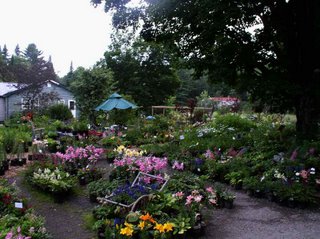 Another beautiful spring day making everyone want to be outside enjoying the warmth and sunshine. I wanted to get home early to do some raking but things didn't turn out that way. I've been trying to get the leaves and branches collected in the "lower garden" but as usual, it's a bigger task than I want it to be. I sat on the garden bench with a cup of cold coffee and enjoyed the sun.
Another beautiful spring day making everyone want to be outside enjoying the warmth and sunshine. I wanted to get home early to do some raking but things didn't turn out that way. I've been trying to get the leaves and branches collected in the "lower garden" but as usual, it's a bigger task than I want it to be. I sat on the garden bench with a cup of cold coffee and enjoyed the sun.Close by the bench is the old barn foundation within which I started a shade garden several years back. The granite and fieldstone slabs pay homage to the strength of the past when men and animals accepted the burden of this type construction and labored on for weeks as a foundation moved into place.
At the end of one of the front walls is a flat rock that just seemed a natural place to toss things I found during the garden building process. Some the the metal shapes offer no idea of their origin but the collection of hand wrought nails of various sizes is very interesting. No need for nails in the current theme of construction but just the thought of history-past weighs more obviously when you grasp a hand-made nail and think back in time. I guess these "found" nails hold part of my mental garden history together.
This is an interesting garden and building it has been fun. The first part was more laborious as the foundation had become a dumping ground for rocks and trash. The foundation was close to the Peacham Pond Road and it afforded an easy place to off-load unwanted property in the days before we moved here. I became friends with the crew at the landfill for a time when cleaning up the mess was the first priority and trips with a loaded pick-up were frequent.
Using stone in garden construction is so very rewarding but it requires some thought ahead of time. Stones rarely move themselves and some are larger than others. Calculating each move in advance cuts down on the work. Crude tools to enhance mechanical advantage also come in handy--a 6 foot pry bar, some wooden blocks for fulcrums and some iron pipes in 2"-3"-4" diameters to use as rollers.
Folks often ask where I learned to do this. There really was no course to take, no book to read, no mentor for me. It was more a mix of time and trial.....and a plan. As I sat on the garden bench I reminded myself of the garden plan which had come this far. Today I saw some buds starting to show on the European ginger; the hellebores are forcing their first new shoots out of the cold ground; a few lone Trillium grandiflorum are breaking ground. My plan is well underway but long from finished. History covers time.
George Africa
http://vermontflowerfarm.com

